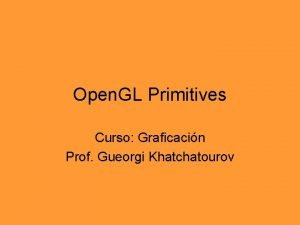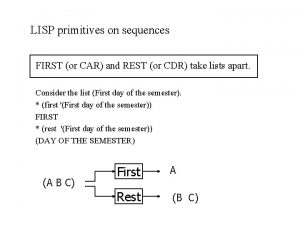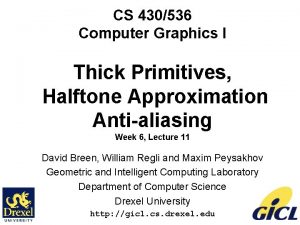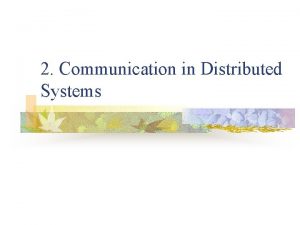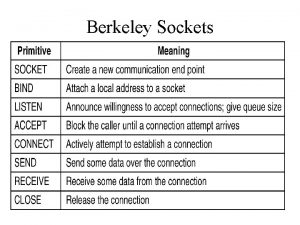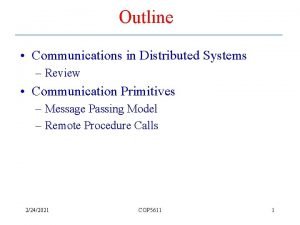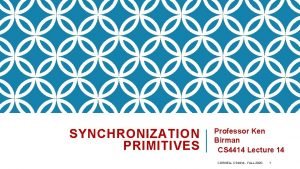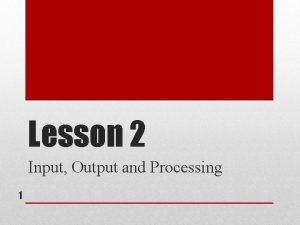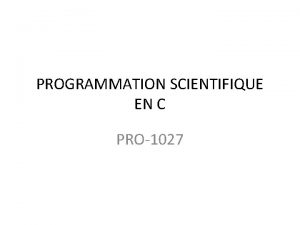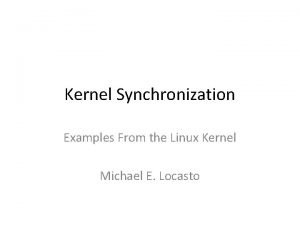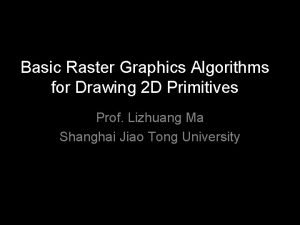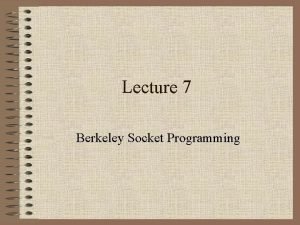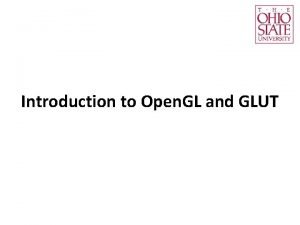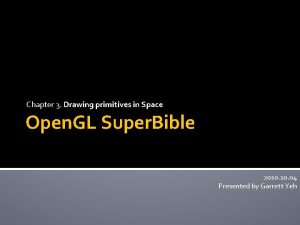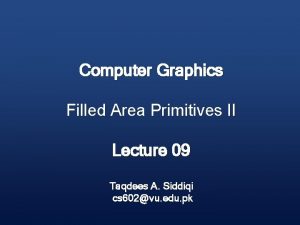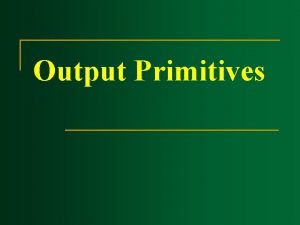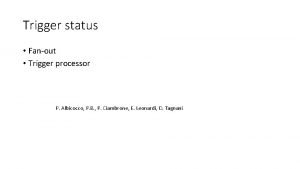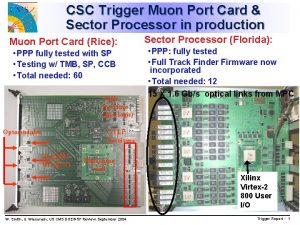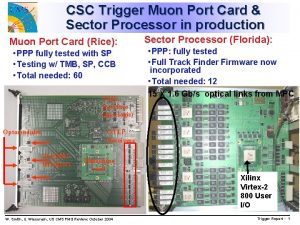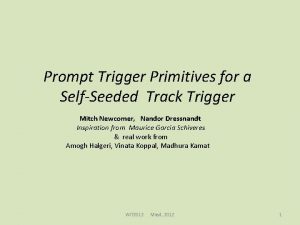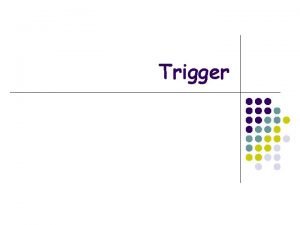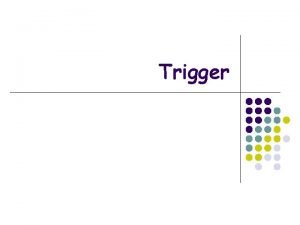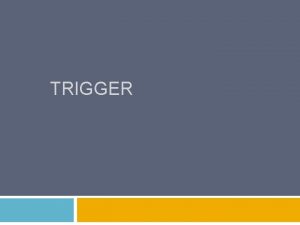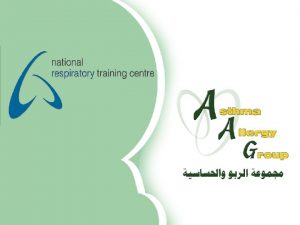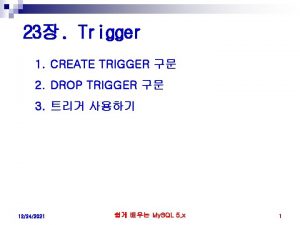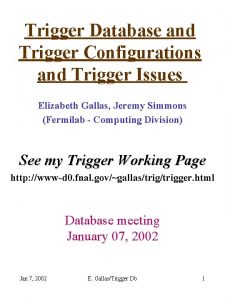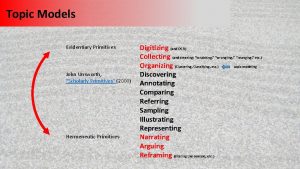CSC L 1 Trigger Status Primitives Sector Processor


















- Slides: 18

CSC L 1 Trigger Status: Primitives + Sector Processor Greg Rakness University of California, Los Angeles CMS L 1 Trigger Meeting CERN 7 November 2006 G. Rakness (UCLA)

MTCC Phase II summary: CSC in global DAQ running during all of phase II, except when requested to be removed… • 36 chambers (full 60 slice in 3 stations) • (mostly) singles from any station • one run of coincidences per field level • bulk of CSC operation was by shift crew + experts on-call YE 3 ME 4 7 November 2006 ME 3 YE 2 YE 1 ME 2 G. Rakness (UCLA) ME 1 DT -11 DT-10

CSC Trigger In Peripheral Crate On Chamber Cathode Strip Front End Boards (CFEB) Trigger Mother Board Muon Port Card CLCT FE FE Wire LCT Anode Wire Card Front End Boards (AFEB) RAT RPC – ALCT Transition Board 7 November 2006 Sector Processor OPTICAL MPC ALCT In counting house SP TMB DMB CCB DAQ Mother Board Clock Control Board G. Rakness (UCLA) Local Charged Tracks (LCT) generated on chamber and in peripheral crate… MTCC trigger primitive = coincidence between Anode LCT ( , bunch crossing) and Cathode LCT ( , p. T)

Synchronization taskforce CSC management has created a taskforce to understand the timing, develop and implement the synchronization procedures of the CSC L 1 trigger… Task force leader = Jay Hauser (UCLA) • Important feedback loops touch many facets: • online shifters, on-call experts • local DAQ online/fast-offline Data Quality Monitoring • critical upgrade added Track Finder (SP) data to DQM • offline analysis 7 November 2006 G. Rakness (UCLA)

Some tasks performed… • ALCT mirror firmware downloaded correctly to station 3 • Trigger primitive settings chosen and constant for Phase II: • ALCT*CLCT coincidence • ALCT layer requirements: 2/6 pretrigger (determines timing), 4/6 pattern • CLCT layer requirements: 4/6 pretrigger, 1/6 pattern • ALCT thresholds/fine delays • software upgrade includes comparison of configuration parameters set on the hardware (read through VME) versus intended values in xml file (transparent to change to database) • Trigger primitive configuration downloading from proms after hard reset successfully tested • open trigger windows to catch data which we might have missed why would we have missed it? • Compare trigger data through DAQ path with that through TF data path • Local runs triggering on single chambers • Test runs with “theoretical” settings from cable lengths under investigation 7 November 2006 G. Rakness (UCLA)

ALCT fine delays Insert before/after picture from Paolo Bartalini’s DQM plots… 7 November 2006 G. Rakness (UCLA)

Fraction of matched LCTs at TF and DMB for all chambers combined for different MTCC runs 99. 9% 4 5 6 1. 2. only 3 ½ hours 1 3. separates these runs 2 4. 3 5. 6. 4371 4275 4244 4218 4190 4189 4188 4186 4138 4129 4065 4026 3999 3973 3802 3797 3793 2553 7 November 2006 G. Rakness (UCLA) End of phase I (end of August) Beginning of phase II (Oct 9 th, run 3793 is from Oct 14 th) Time-in SP (Oct 15 th) and ALCT firmware updated (Oct 18 th) AFEB delay fixed & DDU firmware updated & TTC software updated (Oct 23 rd) LCT-L 1 A window widened (Oct 24 th) 1 run with old AFEB Delays D. Matlock (UCLA) run number

Strip occupancy as expected ME 3/2/27 ME 2/2/27 ME 1/3/27 7 November 2006 ME 3/2/28 ME 3/2/29 ME 2/2/28 ME 2/2/29 ME 1/3/28 G. Rakness (UCLA) ME 1/3/29

Data eff around ME 2/2/28: OK ME 3/2/27 ME 3/2/28 ME 3/2/29 ME 2/2/27 ME 2/2/28 ME 2/2/29 ME 1/3/27 ME 1/3/28 ME 1/3/29 7 November 2006 G. Rakness (UCLA)

RPC pad bit multiplicity/time bin When “should” RPC data arrive? It depends… Multiplicity “reasonable” for cosmics… • To resolve multi-hit ambiguities… before the drift-delay finishes • To use in CLCT pretrigger decisions… before the CLCT pretrigger arrives… This “looks like” RPC data What is stuff at time bin 0? It goes away when a cut is made on: Drift delay finishes here 7 November 2006 CLCT “pretrigger” arrives here G. Rakness (UCLA) • RPC pad bit multiplicity = 1 RPC data may be arriving too late for CSC to use…?

Key wiregroup (~ ) RPC pad bit correlation with CSC position Cuts: • RPC pad multiplicity = 1, LCT multiplicity = 1 • TMB quality > 13 (at least 5 hits on ½-strip pattern) RPC bit=3 RPC bit=1 RPC bit=2 RPC bit=0 RPC bit=7 RPC bit=5 RPC bit=8 RPC bit=9 RPC bit=10 RPC bit=11 RPC bit=6 RPC bit=4 ½ - strip (~ ) Clear correlation of RPC pad bit with CSC position… • Does not cover entire chamber (low wiregroups missing, ½ of middle wire groups) • Where is bit 10? • Edges covered by bit 3, 4, and 8 in a strange way… • Why are bits 8 -11 mapped to a much larger area than bits 0 -7? 7 November 2006 G. Rakness (UCLA)

Sector processor section… Slides from Dan Holmes University of Florida ( ) 7 November 2006 G. Rakness (UCLA)

TF recent news… • Overall TF has run stably in MTCC… – BGo controlled • once configured, TF is controlled entirely through the TTC distribution – 1 S-LINK • commissioned during MTCC; data has been reliably sent to global DAQ – 2 FMM responses • from the SP & the TF DDU. Genuine errors appear as they occur. • Two SPs; – Second SP tried out in TF crate 3/11/06 • used in trigger path; both SPs send requests to CCB 01 path, all LCT rate unchanged • both SP data sets seen in DAQ path • some issues with data unpacking, being resolved… 7 November 2006 G. Rakness (UCLA)

TF recent news TF DDU has run consistently during MTCC; – – global DAQ get good trigger data we see genuine errors when they come at the FMM. . but: 1. we see “FEDbad. CRC” read out by global DAQ once every ~400 k events – – – CRC between DDU & SLINK sender card not consistent suggested solution was to raise potential on 3. 3 V line (see on DDU a slightly low value). done 3/11/06, await big stats run. (should come with the CSC DAQ rate test. ) 2. CRC between SP & DDU not consistent – – 7 November 2006 suggested SP f/w update of bit flip did not work problem may be slightly more complex than thought but is is probably just a f/w solution G. Rakness (UCLA)

TF recent news • SP MS GMT GT trigger path – Sat 21 st Oct; saw; • • • real muons coming from CSCs making a track @ TF MS with dummy LUTs passes them on to GMT GT GT distributes trigger back to CSCs latency difference for specific setups was 6 bx, swallowed @ SP but would be better to do at GMT. . • 100% efficiency for SP tracks to triggers received – problems seen with GMT/GT + DT + CSC + global DAQ control, (Ivan’s talk? ) – more work planned for this week. • BXA used – SP ‘Bunch Crossing Analyser’ turned on; it allows the SP to trigger using primitives that arrive 1 bx apart. Run on 2/11/06 – saw coincident trigger rate go up from ~43 Hz to ~60 Hz – trigger latency unchanged, ‘split trigger’ assigned to BX of first primitive. – in process of checking data, no problems seen yet. . 7 November 2006 G. Rakness (UCLA)

TF recent news • DT & CSC track finder primitive exchange – MTCC 1 we timed in incoming DT stubs • i. e. the CSC can trigger on the overlap region • saw some timing variation in DT stubs (even wrt DT trigger). Little data from MTCC 2 as DT masked out MB 2/1 in Lorentz Angle studies. – Timing in CSC stubs DT-TF? • we have been sending stubs to DT whenever we have ME 1(/3) running, regardless of trigger • Sat 21 st; a few hours of effort in TTC triggered pattern injections ala 904 studies. • more work planned for this week – I will not be here Friday but Frank can cover me to a good extent. – I think the work is basically on the DT side to time CSC primitives into their trigger but I have some suggestions of how CSC can help in the slides that follow 7 November 2006 G. Rakness (UCLA)

TF recent news • DT & CSC track finder primitive exchange I think I learnt from 904; CSC data delay CSC here 6 bx now I see in SX 5; timed CSC trigger timed DT trigger timed delay DT here ~4 bx DT data Ø If nothing in the primitive paths changed since 904 then we can use the arrival of the DT stubs at the CSC TF to work out where in the DT path the CSC stubs should be arriving. Ø Guess is that maybe DT should try delaying their stubs by ~10 bx ± 2 Ø Why not use this as a ball park figure, histogram DT overlap trigger rate @ CTC as a function of variations about it? ? (brute method). 7 November 2006 G. Rakness (UCLA)

TF recent news Some suggestions for what else the CSCs can do for you… • we can make a CSC trigger only on ME 1/3 • HV solution; turn of 1/1 & 1/2 chambers & use ME 1 singles • MPC solution; mask 1/3 chambers to MPC links with MPC CSR 4==0 x 8 BDB. Run TF ME 1 singles – now you get a trigger every time you get a stub – DT & CSC trigger are in time at the CTC. – can DT read out a FIFO and spy on where the stubs are arriving relative to the trigger. . ? – we can play with the CTC trigger latency or to help search for the stubs. . • we can make pattern injections on BGos – very configurable – I really don’t favour this as I think we have seen that practically it is a time eater • timing paths to the two TF are different 7 November 2006 G. Rakness (UCLA)
 Gueorgi khatchatourov
Gueorgi khatchatourov Common lisp car
Common lisp car Thick primitives in computer graphics
Thick primitives in computer graphics Buffered vs unbuffered primitives
Buffered vs unbuffered primitives Output primitives
Output primitives Socket primitives of tcp
Socket primitives of tcp Communication primitives in distributed operating system
Communication primitives in distributed operating system Cs 4414 cornell
Cs 4414 cornell Curve attributes in computer graphics
Curve attributes in computer graphics Processing
Processing Data integrity in hadoop
Data integrity in hadoop Tableau des dérivées
Tableau des dérivées Linux
Linux Basic raster graphics algorithm for 2d primitives
Basic raster graphics algorithm for 2d primitives Berkeley socket i/f
Berkeley socket i/f Glut primitives
Glut primitives Gl primitives
Gl primitives Filled area primitives in computer graphics
Filled area primitives in computer graphics Data mining primitives languages and system architecture
Data mining primitives languages and system architecture
